ISSN ONLINE(2319-8753)PRINT(2347-6710)
ISSN ONLINE(2319-8753)PRINT(2347-6710)
Ram Krishan 1, Dr. Vijay Laxmi 2
|
| Related article at Pubmed, Scholar Google |
Visit for more related articles at International Journal of Innovative Research in Science, Engineering and Technology
Wireless local area network (WLAN’s) using single channel have limited bandwidth. Channel interference between Access Points (APs) of WLAN also decreases the network throughput. The solution of this problem is to transmit data simultaneously on multiple channels is considered as an alternative. In this paper, we propose a channel assignment algorithm for wireless local area network (WLAN) to analyse and enhance the network performance. The proposed algorithm finds the best suitable channel assignment option in order to attain desired performance. We use the RIVERBED MODELER simulator to simulate the WLAN environment with different channel assignment schemes. Simulation results with fixed and mobile (STA) stations demonstrate that our proposed channel assignment algorithm improve the network throughput 2 times higher as compare to other channel assignment schemes.
Keywords |
| Channel Interference, WLAN, Throughput, Network Performance, Riverbed Modeler. |
INTRODUCTION |
| In this paper we study the problem of how to assign the available channels [1] to among access points in WLAN environment. Frequency (or channel) allocation [2] is a well-studied subject in cellular wireless telephony [3, 6], where it has been guided by two design principles: frequency reuse based on a cellular architecture consisting of hexagonal cells and permanent allocation of channels to different cells. |
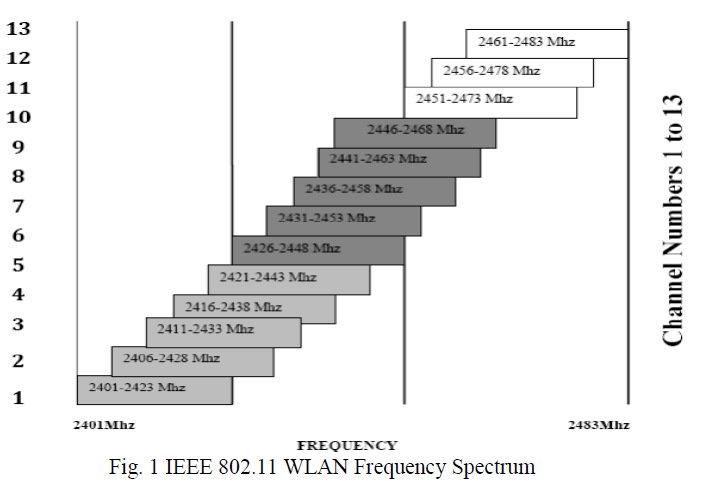 |
| In IEEE 802.11 Wireless Local Area Network (WLAN) only 14 channels are used out of which three channels 1, 6 and 11 are non-overlapping [3, 13], as shown in Fig. 1. The frequency gap between two adjacent channels is 5 MHz. For instance, channel 1 range is from 2.401GHz to 2.423 GHz and its center frequency is 2.412 GHz [5]. The increase in access point (APs) deployment directs the researchers to develop new channel assignment algorithms [9] to reduce cochannel and adjacent channel interferences [10, 13]. Such channel interferences degrades the overall network performance. For example, consider the WLAN consisting of 6 APs shown in Fig. 2 [2]. In this figure the presence of an arrow between each pair of APs indicates that they interfere with each other. |
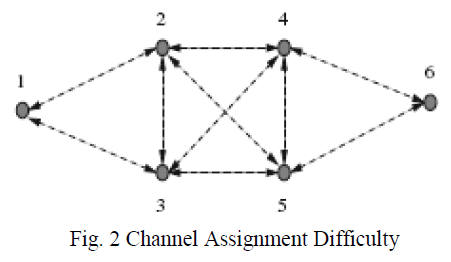 |
| In other words, concurrent transmissions (using the same channel) by each pair of APs connected by an arrow interfere with one another. Clearly, with only three channels, there is no way to assign channels to APs without at least one pair of connected (and hence interfering) APs being assigned the same channel. A channel that is available at a given time and in a given segment of the network may be unusable later due to external interference. |
II. RELATED WORK |
| In [13] the authors proposed a WLAN channel management algorithm to maximize the network efficiency by managing users on different channels so that the network throughput is maximized. This algorithm is uses a software agent to manage and communicate with the network APs. This algorithm shows the efficient management of users and increases the WLAN channel utilization. The work in [2] presents frame-based channel allocation architecture for WLANs. Authors proved that the system throughput can be optimized by scheduling APs and allocating channels in each frame such that a weighted queue sizes at the activated APs is maximized. The authors of [15] proposed a channel scanning technique to minimize the disconnection of the wireless stations. They introduced a channel scanning method in which wireless station scans the channels selected by the Neighbor Graph. In [16] an algorithm for Channel assignment is presented to maximize the (SIR) at user level for appropriate channel assignment at each AP. This algorithm minimizes the interference between APs and assigns channel to each AP after calculating SIR for each user. Work in [14] presents an un-administrated wireless local area network (WLAN) channel assignment to enhance the quality of WLAN by using the capacity of the IEEE 802.11 frequency spectrum. |
III. PARAMETERS AFFECTING THE WLAN PERFORMANCE |
| The following are various parameters affecting the WLAN performance [3, 10]. |
1. Number of Users |
| The number of users associated with network affects the performance as the medium is shared. The increase of users associated with an AP causes the higher interference in the neighbouring cells. |
2. Channel Interference |
| The channel allocation becomes very difficult when deploying WLAN. There are two types of channel interference. |
| ï· Adjacent channel interference between two access points is caused due to the fact that APs may share the same frequency bandwidth |
| ï· Co-channel interference takes place between APs using the same frequency channels. |
3. Communication load |
| The communication load [4] is the amount of traffic that an AP is forward to its associated clients. As the load on AP is increased it affects the network throughput. |
4. Power Signal |
| There is a minimum threshold power value for receiver that the received signal must have to reach at this bit rate. If the received signal power is lower than the threshold the maximum bit rate [12] could be decreased, impacting performance. |
IV. MATHEMATICAL REPRESENTATION OF OUR ALGORITHM |
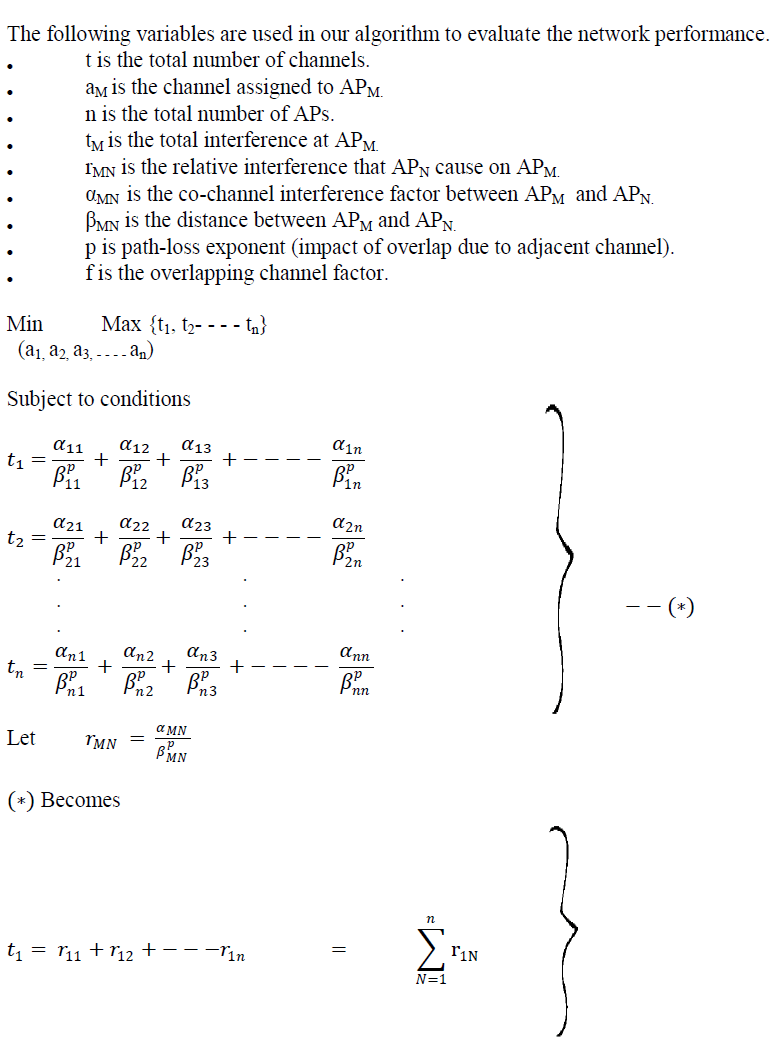 |
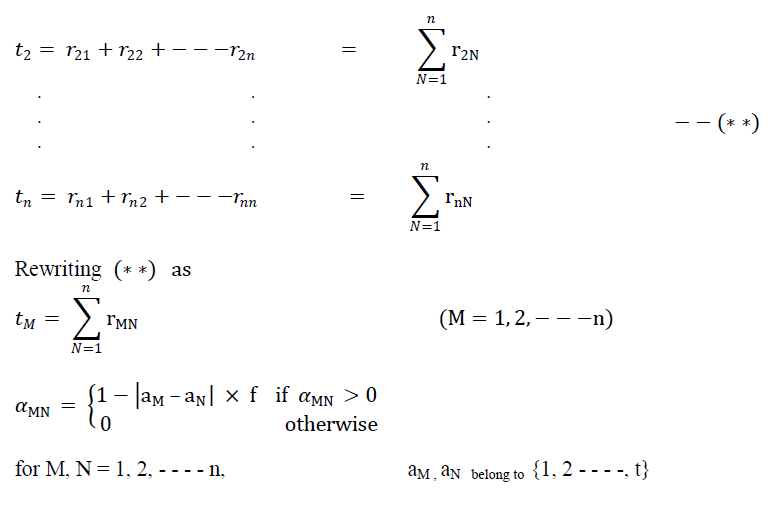 |
V. EVALUATION OF CHANNEL ASSIGNMENT ALGORITHM |
| Our channel assignment algorithm is evaluated through extensive RIVERBED MODELER [7, 11] simulations. We compare our channel assignment algorithm with three other channel assignment schemes. Simulation results with fixed and mobile (STA) stations demonstrate that our proposed algorithm enhances the WLAN network performance in terms of delay, data dropped, retransmission attempts and throughput. The number of users associated with network affects the performance as the medium is shared. The increase of users associated with |
1. Common Channel Assignment (CCA) |
| In this type of channel assignment only one common channel is assigned to all the APs. This is a very common approach where all APs use a default selected channel (like channel 6). The manufacturers of network devices designed their products which work on a default channel and this condition is generally applied in the wireless local area network. |
2. Random Channel Assignment (RCA) |
| In this type of assignment the owner of the APs select any random channel without knowing the channel interference constraints of the network. |
3. Non- overlapped Channel Assignment (NCA) |
| In this type of assignment only non-overlapped channels are assigned to the APs. In case of 802.11g mode of LAN channel 1, 6 and 11 are non-overlapped channels. We evaluate the efficiency of proposed algorithm with best suitable channel assignment option in order to attain desired performance. |
VI. NETWORK SETUP DETAILS |
| We used Riverbed Modeler 17.5 [11] simulator to implement the proposed assignment algorithm. Fig. 3 presents the WLAN setup with Wireless_lan and Wireless_lan_adv model families. The Access Points and wireless stations (STA) are distributed in a service area of 1 × 1 kilometre. Wireless LAN Workstation and Wireless LAN Server nodes are used as wireless stations, APs respectively for network simulation. We perform our simulations with 802.11g mode of operation and performance of proposed algorithm is compared with three other channel assignments schemes CCA, NCA, RCA. In CCA (Common Channel Assignment) scheme, channel 6 is assigned to all access points AP1 to AP4. |
| In NCA (Non-overlapping Channel Assignment) Scheme, channel 1, 6, 6 and 11 were assigned based on minimizing interference among neighboring APs to AP1 to AP4 respectively. In RCA (Random Channel Assignment) Scheme channel 3, 6, 7, and 11 assigned to AP1 to AP4 respectively. Finally, in proposed algorithm scheme channel 1, 6, 5 and 10 were assigned to AP1 to AP4 for optimal channel assignment. Only one scenario is created and other was duplicated while modifying the channels at each AP. |
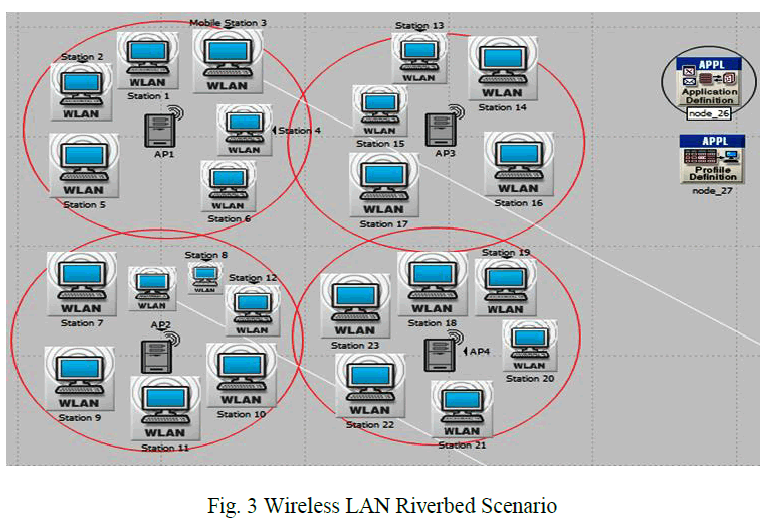 |
VII. SIMULATION RESULTS |
| To analyse the performance of proposed channel assignment algorithm we simulate the wireless LAN environment described in figure 3 using the Riverbed Modeler 17.5 [11]. The simulated network contains 4 fixed APs, 22 workstation nodes, 2 mobile stations, an application definition and profile definition. This wireless network is simulated four times with common, non-overlapped, random and proposed channel scenarios. |
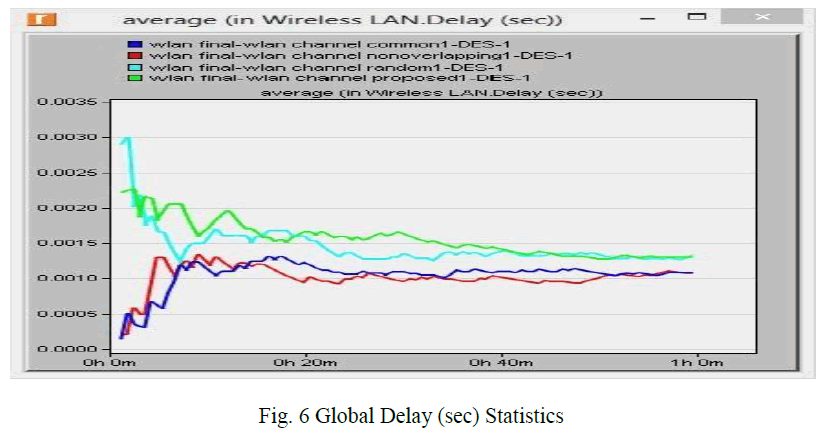 |
| Figure 6 shows the global delay (sec.) statistics. It represents the delay of packets received by all WLAN nodes in wireless LAN and forwarded to higher layer. We observe that the average delay for our proposed algorithm is reduced by 10 to 20 percent. The mean value for data dropped in all schemes is above 0.00100 seconds. |
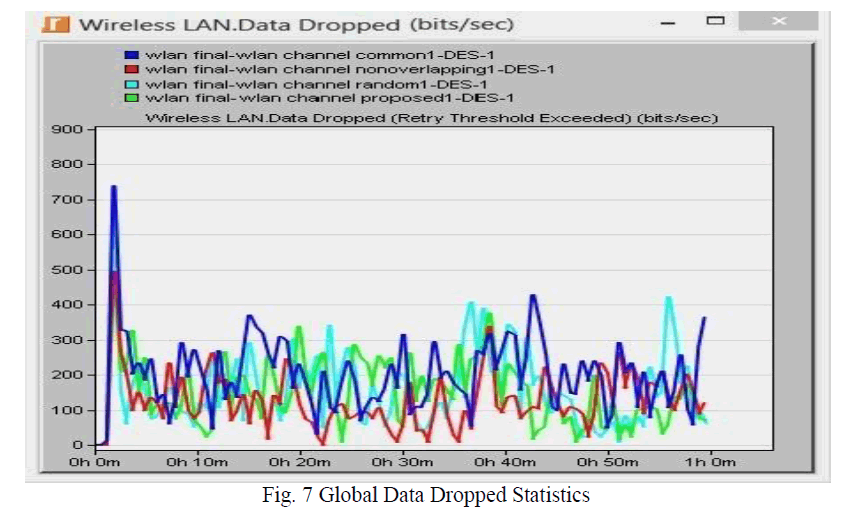 |
| Figure 7 plots the total higher layer data traffic (bits/sec) dropped by WLAN nodes because of inconsistent retransmissions. The amount of global data dropped in case of our proposed algorithm is equal to the NCA and lesser than the CCA, RCA schemes. So global data dropped in our proposed algorithm is comparable to all other schemes. |
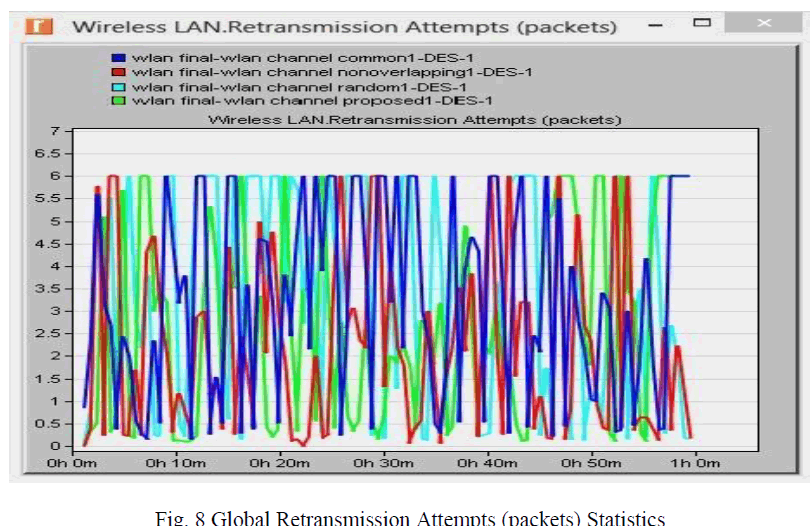 |
| Figure 8 represents the number of retransmission attempts by WLAN nodes in the network waiting for packets to be transmitted successfully or discarded due to short or long retry limit. Result shows that the minimum and maximum values of retransmission attempt for proposed algorithm are 0.056 and 2.56 respectively which is lesser than among all other algorithms. |
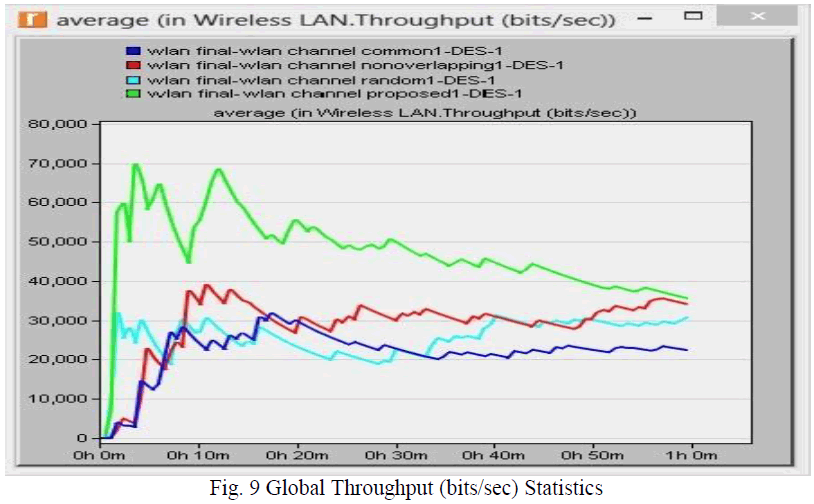 |
| Figure 9 represents the number of bits/second forwarded to higher layers by all wireless nodes of the WLAN layer in the network. We observe that our proposed algorithm shows maximum throughput among all the other algorithms. With proposed algorithm the amount of throughput is 2 times higher as compare to all CCA and RCA. In case of NCA our proposed algorithm gives much better throughput result. The maximum value and mean value of throughput for all the schemes is given in table I suggests that our proposed algorithm performs better with compare to other scheme. |
 |
| We can conclude that our proposed algorithm provides better network performances in the wireless LAN. With proposed algorithm it is possible to manage the available channels and enhance the global WLAN performance. |
VIII. CONCLUSION AND FUTURE WORK |
| This paper presents a new channel assignment algorithm to enhance the performance of wireless local area network (WLAN). We use the Riverbed Simulator to show the results of wireless local area network with static and mobile user environment. By assigning available channels optimally to different access points the global statistics shows the better performance of proposed algorithm as compare to other schemes CCA, NCA and RCA. Riverbed Simulator result shows that the proposed algorithm gives the 2 times higher throughput as compare to all other schemes. In future we can extend our work to more complex scenarios with higher number of AP and dense user environment. |
References |
|